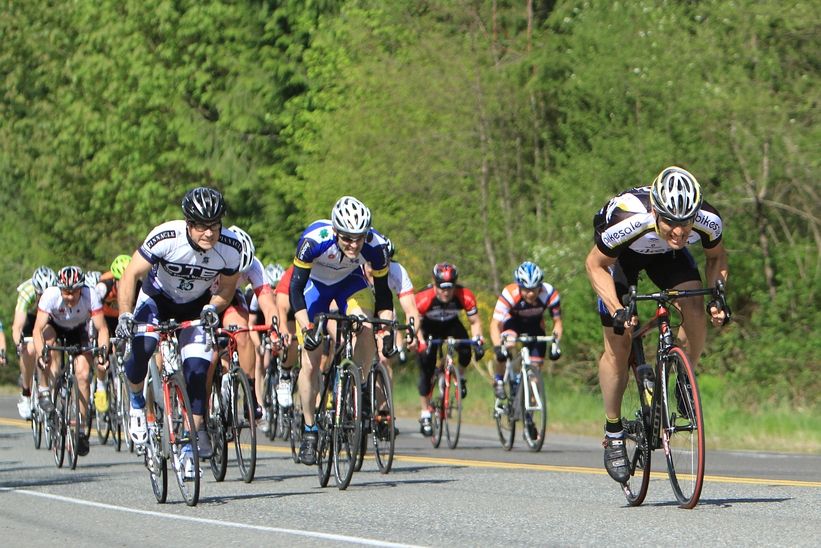The Breakaway
In every race and on any course at least one thought will enter every racer’s mind: where will the winning breakaway take place and under what circumstances? In this post I’ll discuss what I’ve learned from Thomas Prehn and Edmund R. Burke, authors of Racing Tactics for Cyclists and Serious Cycling.
Road racing is partly about energy management, and part of that management is timing. Another part is situational awareness. In the previous posts I mentioned “reading the race.” When known strong riders or a particular teams strong riders start to position themselves near the front, it’s time to take notice. Sooner or later one of these riders will jump. This will happen at a place that tactically makes sense, like the top of a hill, a turn in the road, a bottleneck, or anywhere where it would be difficult for the pack to maneuver or negotiate.
Burke wrote this statement that made sense to me, “It is said that the doubling of speed requires a fourfold increase in energy expenditure.” One must be careful on where and when to burn a match.
There’s a curious effect when a column of racers are in motion, and I have no doubt that you’ve experienced this effect. I can liken it to an accordions motion. When that lead racer jumps there is a split second of pause as the second in line decides and acts remember situational awareness—and decision cycles that I mentioned earlier? By the time that decision cycle has progressed back to you, at the fifth position; a gap or gaps may have opened. Or has it?
The situationally-aware racer will anticipate the leaders jump and accelerate simultaneously. We all know that during a race there are numerous jumps, attacks, or surges. All these accelerations add up, all these accelerations will drain your energy reserves. The trick is knowing which one to go with, and which ones are done just to wear-down the pack or done for other reasons. I remember during one road race a competing team’s rider was sent to the front to attack. I had properly guessed that he was there just to string the pack out and wear us down. We had many miles to go and a breakaway at this point just didn’t make sense. He was certainly a tractor and he stretched the pack out. Those of us that knew what was going on just sat in for the free draft.
There are some occasions and locations on when to anticipate the jump leading to a viable breakaway. Above I mentioned when key racers amass at the front, other situations are:
- When you are approaching a hill or other significant terrain feature;
- When a prime is announced as breakaways will occur by those who conserved their energy by not contesting the prime;
- When there are crosswinds. Especially when those crosswinds will involve the formation of crosswind echelon.
- When there are sharp turns in the road like an intersection. Racers usually slow down to negotiate the apex. Other racers know this which is why they usually stomp on it after rolling-through.
One question that should come to mind when key riders mass at the front is: who is likely to work together when a breakaway forms? If the answer is “most of them,” it would be a good idea to be involved in that breakaway because they’re probably going to be serious about exploiting a gap from the pack. A related question is if this breakaway happens, do the riders have teammates in the pack who will block for them? If so, this will assist the breakaway in its escape. If not, a motivated pack will soon neutralize the break by working together.
Whether you’re in the break or supporting a teammate in the break up the road, another factor to be aware of is split-time. Split-time is the time difference between the last rider of the break and the first rider of the chasing pack. In a criterium, this will be a sum of seconds. For example, 15 seconds is a tactical advantage and can be tough to nullify. In a road race the equivalent gap might be more like 45 seconds to a number of minutes. Here’s the issue: the split-time will either increase or decrease depending on the dynamics of the race. If your buddy is in the break and split-time is decreasing, you might want to start blocking in order to protect his escape. If the split-time remains the same or is increasing, you might not want to draw attention to the increasing gap by blocking. Additionally, blocking consumes energy, and can create hostility, but that is the subject of a different post.
Gaining reliable measures of split-time can be challenging. If you have line-of-sight, you can use your cyclometer, watch, or other instrumentation to reliably measure the gap. If radios are allowed in your race, your team director might relay it. Relying on spectators’ information isn’t recommended as you don’t know the quality of data; and I wouldn’t recommend basing decisions on it.
In the end, the road race is a dynamic situation, “…don’t calculate too much. You must be able to react and employ the tactics quickly when necessary.”
That’s it for basic breakaways. In Part 4 I’ll talk a bit about sprinting.







Recent Comments: